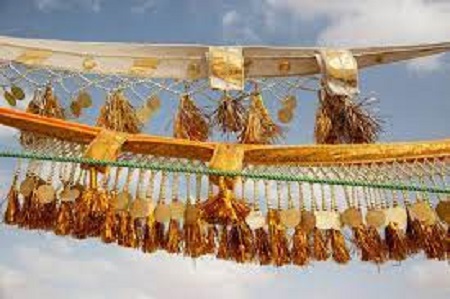I’d just arrived at the Al Dhafra Festival, and young boys dressed in kanduras, or long tunics, were running toward my car, shouting and pointing their index fingers in the air. Two men rode camels in the distance, each pulling one of the animals on a leash. A gold-tasseled winner’s blanket was draped over one of the camels.
A large convoy of honking pickup trucks was slowly making its way across the sand dunes behind the men. Men and boys stood in many of the vehicles and leaned out all of the windows, waving and cheering, with many filming the scene on their phones.
I left my little rental car behind — I wouldn’t have gotten out of the deep sand anyway — and jumped on the back of the nearest pickup. I wanted to be a part of this spontaneous celebration.
The annual Al Dhafra Festival celebrates Bedouin traditions and takes place near the Emirati city of Madinat Zayed, a two-hour drive southwest of Abu Dhabi, at the ede of the Rub al Khali, or the Empty Quarter, considered the world’s largest sand desert.
The gathering’s highlights include Saluki races (the dogs are prized by the Bedouin for their speed and vision), poetry readings, and exhibitions on readings,y and traditional artisanship. There is also a variety of food and drink available, ranging from fresh dates to camel milk.
The camel beauty contests, on the other hand, are at the heart of the festival.
During the weeks-long event, Al Dhafra was the camel universe’s epicentre. More than 24,000 camels from all over the Middle East competed for 60 million Emirati dirham in prize money in 2019, the year I attended — the equivalent of more than $16 million. Large sums of money are also exchanged when particularly beautiful camels are sold.
Some contestants trace the origins of the beauty pageants back to a family feud in 1993, when two camel breeders had to rely on outside judges to determine which of their animals was more beautiful.
Camel beauty pageants have since grown into a multimillion-dollar industry, with state-sponsored heritage festivals held across the country.
The Al Dhafra Festival, which was formally launched by the government in 2008, aims to celebrate Bedouin culture, generate tourism, and preserve the purity of specific camel breeds.
In the last fifty years, Bedouin society has all but vanished. Nomadic herding patterns have been stifled by modern borders, and the encroachment of economic and technological change has upended other traditional cultural practises.
Festivals like Al Dhafra are one of the few ways for urbanised Bedouins to meaningfully sustain their traditions.
Camel beauty contests are divided into various categories based on breed, age, ex, and whether the camel is sex,ed by a sheikthe or a tribesman. However, the criteria remain the same.
The ideal camel has long straight legs, a long neck, a shapely hump (in the right spot on its lower back), pert ears, expressive eyes framed by upward curled eyelashes, long droopy lips, and, of course, an elegant posture.
No supermodel is complete without jewellery, and an entire industry has sprung up around beauty pageants to provide the necessary adornments. Camel tailors, for example, set up shop in Al Dhafra Festival, selling bright reins, gleaming camel blankets laced with tinsel tassels, and even glittering necklaces made of plastic beads and stringed coins.
Million Street, where the camel superstars parade, is transformed into an open-air market of tents, caravans, and food trucks.
Thcaravans is more than just a place to buy camel tack and shampoo. Colorful winter blankets, coffee serving sets, stoves, rugs, hunting gear, foldable chairs, waterskins, and an assortment of waterskins are also available. Restaurants that serve kebabs, cakes, and sweet karak chai are advertised with bright lights. There are even laundry services to keep the celebrants — both people and camels — looking their best.
During the festival, Emirati women play a limited role. Women and children, who are traditionally barred from competing in camel races, spend the majority of their time in their family tents or at a nearby market.
As a foreigner, however, I appeared to be exempt from the gender restrictions and was able to walk around freely, attend camel beauty contests, and join the owners at the winners’ celebrations during my three-day visit.
Canopies adorned with thousands of lights began to sparkle among the dunes as the sun set and the sky turned a dusky purple. Inside were members of the Bedouin tribes, who had travelled from all over the region to honour their traditions. Each tribe had erected a flamboyantly decorated tent.
I was invited to join the men of the Almuharrami family in their illuminated tentinllowing Waheela, a beauty queen, to celebrate one of their camels’ victories.
“She was just named the most beautiful young camel in the Middle East,” Muneef, her 12-year-old owner, said proudly.
The music then started, and the men lifted their bamboo canes to perform the yowlah. Men chanted poetry and acted out a battle scene during the traditional stick dance. The sky had turned inky black by the time we left tscenesrty, and the revelry had lasted well into the night.
Kiki Streitberger is a documentary and photojournalist based in London and Germany. You can keep up with her work on Instagram.







